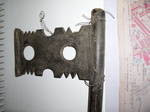One of the things which has exercised my mind since setting up felting at Kentwell Hall has been that of wool.
The first year (2006) we just had the wool from the Norfolk Horn sheep that live on the Manor. We found this wool was difficult to work with which set me to wondering why it didn't felt easily; if we could make it easier; and what wool actually would have been used in earlier times.
The Norfolk Horn is a predecessor of the Black faced Suffolk Sheep, I have now found out that felters today generally consider working with this wool to be a wasted energy. With perseverence we have got it to felt albeit the results are springy and prone to pilling. However all things have their purpose and this has given great comfort to a number of feet (insoles) and backsides (seat pads). I also experimented and found that it was more suited to needle felting - not a lot of good for Tudor times but a handy 'mend it' option for when visitors have gone home!
The best sheep wool for felting has the right thickness, the right crimp and the right staple (I think I will do a seperate post about this another time).
Turning my thoughts to how can we make this easier I wondered about water; soap; and the wool.
With experimentation we found that the hotter the water the better - that was some progress.
Would it make a difference if the soap we used we more akin to that used in Tudor times? we made our own soap but found that although its a great talking point, it didn't make a lot of difference to the felting, its just very rough on our hands.
Was soap even used to create the right enviroment to get the wool to felt? don't know about that one yet!
I have heard of carrotting for other felting fibre (rabbit, beaver), is there anything that could be done to make this wool easier to work with. Recently I found mention of felters using short staple wool and felters choping wool to shorter lengths. We have yet to give this serious try.
These days felters seem to favour Merino wool imported from Australia, I didn't think we would be importing wool from Australia in the 16th century so that option seemed to be out and I have been trying to identify other options. There has been mention of 'Estridge Wool'; 'Wool from Pollonia'; 'Spanish Felt Wool' in the OED on line (see 'F' words) and in the information about Monmouth caps there is reference to 'Ryedale Wool'. This year "one who knows much of such things" did say to me that much wool was imported from the Baltic areas? What other sheep would there have been around at the time?
In my modern life I was introduced to Blue Faced Leicester which felts beautifully in no time at all. I don't know if this wool would have been around at the time but we bought some, a beautiful soft brown colour and all ready prepared to use this summer - we had our most successful hat making outcomes yet. I am really proud of the hat I made, I will try and post a picture soon!
Since the summer I have been exploring options from the Baltic and was kindly sent samples of Finnwool and wool from the Gotland sheep by Rod Finland (http://www.rod.4felts.com/ just have a look at his web site for inspirational modern felting!). I have made some small samples and am most impressed with the results. I need to experiment with these a bit further.
I have recently found out that the modern Merino Sheep are descended from Spanish Sheep and am guessing that these were the sheep which provided the fine 'Spanish Felt Wool'. Maybe we can legitimately use Merino after all!
Next I want to try and get hold of the fleece of a Ryedale sheep and find out exactly what is Estridge Wool? - any ideas?
Tuesday, 9 September 2008
Subscribe to:
Post Comments (Atom)




2 comments:
It is the Norfolk Horn sheep breed at Kentwell - not Longhorn. Sorry you don't like the fleece, I have sold a lot to happy home spinners!
www.norfolkhornsheep.co.uk
Thanks for putting me right on the name of the breed of sheep at Kentwell - I'll correct that.
You are right the fleece is great for spinning - it just doesn't felt well. Hope you don't take it personally!
Post a Comment